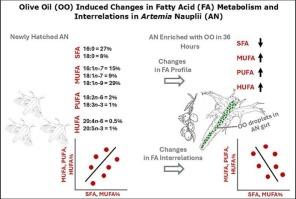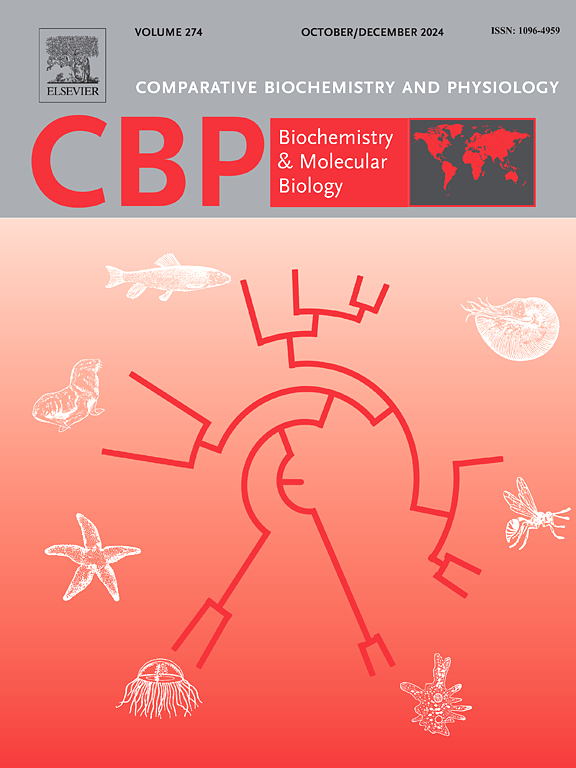Plant oils induce fatty acid plasticity in Artemia – A comparison among newly hatched, starved, and enriched nauplii
IF 1.8
3区 生物学
Q4 BIOCHEMISTRY & MOLECULAR BIOLOGY
Comparative Biochemistry and Physiology B-Biochemistry & Molecular Biology
Pub Date : 2025-06-11
DOI:10.1016/j.cbpb.2025.111117
引用次数: 0
Abstract
Artemia nauplii (AN) are commonly fed as live prey, although they are deficient in certain fatty acids (FAs). To address this deficiency, AN are directly enriched with the necessary FAs. However, while the use of plant oils (POs) in aquafeed is common practice, their applicability toward mass production of enriched AN has not been fully explored. The goal of this study was to investigate the flexibility of AN FA synthesis in response to POs. Three olive oils (OOs) derived from single-cultivar trees (Kor, Par, and Arg) were used to enrich AN. Newly hatched (AN0) and 36-h starved AN (AN36) were designated as unenriched groups. While certain FAs increased (16:1n-7, 18:1n-7, 18:1n-9, 18:2n-6, 18:3n-3, 20:4n-6, and 20:5n-3) from AN0 to AN36, others, such as 16:0 and 18:0, decreased, indicating ongoing FA synthesis in AN. Regression models revealed interrelationships among FAs in AN36. The AN enriched with OOs exhibited significant changes in their FA profiles and interrelationships. These changes were attributed to either biosynthesis or dietary factors. Overall, the results suggest that using POs, as sustainable enrichment components, can effectively modify FA metabolism in AN to achieve desired FA profiles.

植物油诱导Artemia脂肪酸可塑性——新孵化、饥饿和富集的鹦鹉螺的比较
虽然它们缺乏某些脂肪酸(FAs),但通常作为活猎物食用。为了解决这一缺陷,AN直接与必要的FAs富集。然而,虽然在水产饲料中使用植物油(POs)是一种普遍做法,但它们在大规模生产富集AN方面的适用性尚未得到充分探索。本研究的目的是研究AN FA合成对POs响应的灵活性。使用来自单一品种树木(Kor, Par和Arg)的三种橄榄油(oo)来富集AN。新孵化(AN0)和饥饿36 h的AN (AN36)为未富集组。从AN0到AN36,某些FAs增加了(16:1n-7、18:1n-7、18:1n-9、18:2n-6、18:3n-3、20:4n-6和20:5n-3),而其他的,如16:0和18:0,则减少了,表明在AN中仍在进行FA合成。回归模型揭示了AN36中FAs之间的相互关系。富含OOs的AN在FA谱和相互关系上表现出显著的变化。这些变化可归因于生物合成或饮食因素。综上所述,结果表明,使用POs作为可持续富集组分,可以有效地改变AN中的FA代谢,以获得所需的FA谱。
本文章由计算机程序翻译,如有差异,请以英文原文为准。
求助全文
约1分钟内获得全文
求助全文
来源期刊
CiteScore
4.60
自引率
4.50%
发文量
77
审稿时长
22 days
期刊介绍:
Comparative Biochemistry & Physiology (CBP) publishes papers in comparative, environmental and evolutionary physiology.
Part B: Biochemical and Molecular Biology (CBPB), focuses on biochemical physiology, primarily bioenergetics/energy metabolism, cell biology, cellular stress responses, enzymology, intermediary metabolism, macromolecular structure and function, gene regulation, evolutionary genetics. Most studies focus on biochemical or molecular analyses that have clear ramifications for physiological processes.

 求助内容:
求助内容: 应助结果提醒方式:
应助结果提醒方式:


